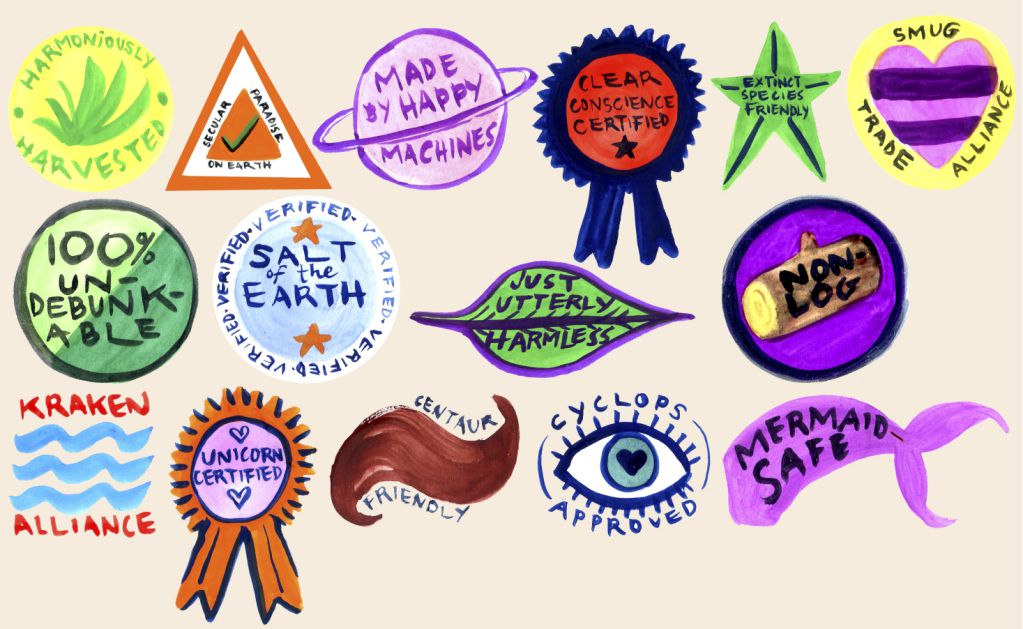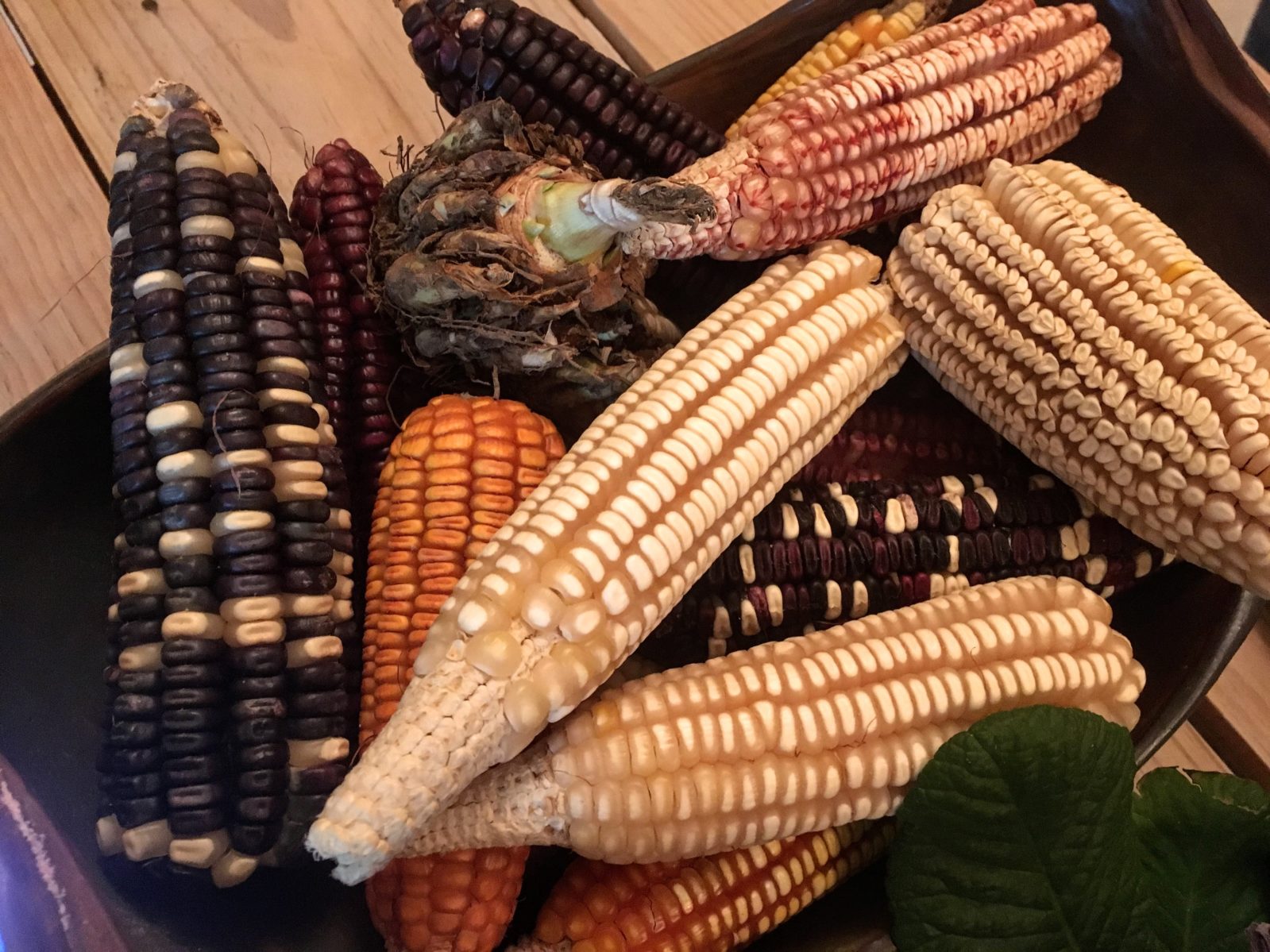
Rawaan Alkhatib
Say you use coffee beans in your chocolate bar. You source them from a co-op in the Dominican Republic, and you want your customers to know your workers earn a good wage. Pay $500 a year (and pass an audit that costs an additional $1,500 or more), and you can put a Fair Trade Certified seal on your product. Are your beans “rainforest-friendly”? The Rainforest Alliance will check you out and vouch for its findings for 1.5 cents a pound—plus annual inspection costs determined by acreage. Maybe they’re shade-grown? The Smithsonian Migratory Bird Council grants a “Bird-Friendly” seal—after you hire a  certification body to inspect your foliage density, canopy height, and “diversity of woody species.”
certification body to inspect your foliage density, canopy height, and “diversity of woody species.”
Welcome to certification nation. As consumers have started paying attention to how products are made, what ingredients they do and don’t contain, and what values they support, hundreds of organizations have stepped forward to verify manufacturers’ claims. Some (like the Migratory Bird Council) are arms of traditional organizations; others are in business just to certify products. They give values-driven companies a way to prove that they’re keeping their promises. And they’ve become their own industry, with some certifiers bringing in more revenue than the companies they inspect. The Rainforest Alliance, for instance, made $12.7 million in certification fees (not all for food) in 2014—roughly a quarter of its total annual funding.
Third-party certifications (TPCs) can be powerful tools. But are they a good investment? Here’s what you need to make the right decision.
Credence Qualities: Consumer-Facing Certifications
The most familiar TPCs cover what is known as “credence qualities”: attributes that cannot be verified by the consumer by visually inspecting a product. You might be able to tell a tomato is fresh by looking at it, but to tell if it’s USDA Organic you need a seal.
“Consumers increasingly want their purchasing practices to reflect their ethical values, or their social values, or their political values,” says Susan Bain, an Iowa State University sociologist who studies retail labeling. “Labels are really important for  allowing political/ethical consumers to meet their desires in the marketplace.”
allowing political/ethical consumers to meet their desires in the marketplace.”
It’s important to note that, with the exception of USDA Organic—which relies on federal law and federally recognized accrediting bodies—,third-party certifiers develop their own standards and procedures.
Or take the issue of humane treatment of animals. The three major TPCs in that area—American Humane, Animal Welfare Approved, and Certified Humane—don’t fully agree on best practices, though they probably have more in common than they do with related TPCs provided by smaller, niche certifiers—like Predator-Friendly Certified, whose practitioners agree to manage roving carnivores without the use of poison or guns.
Which TPCs matter most?
In this sea of choices, two consumer-oriented TPCs stand above the crowd: USDA Organic and Non-GMO Project Verified. That’s for two reasons, says Bob Burke, founder of Natural Products Consulting. First, they affect the broadest range of products.

Retailers seek out products with the Non-GMO Project Verified status, since the certification has no strong competitors and is broadly recognized by consumers
“Non-GMO and Organic are going to cut across hundreds and hundreds of categories and thousands of brands,” he says. “Gluten-free is right up there, too. Where as something like “Humane Certified” is going to be more specialized.”
Then there’s the fact that both USDA Organic and “Non-GMO” rely upon a single, clear standard that consumers recognize and respect.
“Before there was a national organic program,” Burke says, “something like 30 states and 13 certifiers all had slightly different standards. There was a lot of confusion. Once there was a clear national standard, it really helped the category grow dramatically.”
“Non-GMO” has benefited from something similar. Though there are several non-GMO certifiers, Non-GMO Project Verified—with its signature orange butterfly seal—is by far the most broadly recognized. The designation is so powerful, and has such broad visibility, that Whole Foods has partnered with the certifier to develop its own non-GMO standards, rather than develop those standards by itself.

Percent of consumers who said they were “very willing” to pay a premium, by attribute. Source: Nielsen’s Global Health and Wellness Report, 2015
But when a certification category lacks a clear front-runner, Burke says, consumers trust it less. Seals like “Kosher,” “Fair Trade,” or “Gluten-Free”—in addition to being more niche—have multiple certifiers vying for dominance, and competing sets of standards lead to customer confusion. There are almost 70 Kosher certifying agencies in the United States, for instance, over a quarter of them in the New York metropolitan area alone.
And when a TPC doesn’t readily call to mind a specific set of practices, it carries less value. “Paleo Certified” may cater to an influential demographic, but do the fans even know what the seal means?
What does it take to get certified?
TPCs don’t come free. Most programs require a fee (typically low), annual audits, and year-round compliance paperwork. The audits in particular can cost money and time and can be a real burden on smaller companies. Are they worth the expense?  Absolutely, says Chris Baker, an Oliver Wyman consultant who specializes in food retail.
Absolutely, says Chris Baker, an Oliver Wyman consultant who specializes in food retail.
“Obviously, if you’re tiny, selling into farmer’s markets, even a small cost may not make sense,” he says. “But that’s a pretty low threshold, given the way these things are priced.” Especially with the major certifications, “you’ll get credit for it, it’ll carry more weight with retailers, and I definitely think it’s worth doing.”
Burke did give one caveat, though, in terms of “non-GMO”: “If you’re a really early-stage company, and money’s really tight, and you’re in a category that’s at low risk of being non-GMO, then it’s a lower priority.” For example, there’s currently non-GMO wheat flour on the market, so the seal carries less value. But with other products, it’s a different story. “If you’re doing anything with corn or soy or beet sugar in the natural channel, it’s almost a requirement to be certified non-GMO, unless you’re organic,” he said. (USDA Organic products cannot contain genetically modified ingredients.)
Baker had a caveat, too: “If you become successful, just be careful you’re ready to meet the demands of that success,” he said. “Say Whole Foods calls and now they want to carry your product. That’s a life-changing, game-changing thing—you have to have the manufacturing runway and capability to scale up relatively quickly if you hit a big demand spike.” If the demands of finding and putting out a certified product is going to limit your sourcing or manufacturing, in other words, you want to make sure you really have the bandwidth.
Playing Defense: The Global Food Safety Initative
For most manufacturers, however, the most important certification is one that most consumers are mostly unaware of: food safety certification under the standards set by the Global Food Safety Initiative (GFSI)—an international benchmarking organization created in 2000 to standardize food safety rules.

“Becoming GFSI certified is something that most major retail buyers look for,” Baker says. “For most mid- to large-size food processors, manufacturers, and growers, it’s basically just table stakes.” Not being certified will certainly bar you from some markets. Wal-Mart and Kroger, for instance, require it.
“Almost every large grocery chain requires a GFSI certificate at this point,” says Greg Palmieri, president of Empire Food Science, a New York firm that helps with GFSI certification. “I have seen some exceptions on a local level. For example, a product could be in a few local Whole Foods stores and not have a GFSI audit. But this is usually only done if the manufacturer has agreed to get certified by a certain point in time.”
A bit of good news for businesses using a co-packer: if your co-packer is covered, so is your product.
“I’d look for a co-packer that is at least third-party audited or even better, GFSI certified,” said Tim Sullivan, President of the consultancy Sage Foods Group, in a session hosted by Local Food Lab. He said going with a certified co-packer “will reduce barriers to entry.”
GFSI doesn’t directly certify manufacturers. Rather, it created “Guidance Document” to form the basis of modern food safety practices. Nine certification “schemes,” independent benchmarking organizations, determine what practices are GFSI-compliant. Each scheme covers a number of different “scopes,” or types of production—from vegetable farming to manufacture of food packaging. Scopes will be covered by several competing schemes—GFSI offers a handy tool to determine who’s certifying in your space. Each scheme in turn recognizes licensed certification bodies (LCBs)—the boots-on-the-ground companies who actually ensure a company’s compliance and award certification. (Here’s a list of some of the biggest LCBs.)
“The most meaningful difference between the schemes is the location of the scheme owners,” says Palmieri. “The scheme that a company should pursue is mostly based on their location and the location of their customers.” For most U.S. companies that do not export, that would translate into certification through SQF, operated by the Safe Quality Food Institute.
Becoming certified usually requires maintaining certain paperwork year-round, and agreeing to an annual in-person audit. Companies typically work with a consultant before the first audit to ensure they have the best possible chance of passing; Palmieri says fees run from $5,000 to $30,000, depending on company size. The audits themselves cost around $1,500 per audit day—count on paying $5,000 to $7,000 per year.
Looking ahead: The Food Safety Modernization Act
Of course, another food safety standard looms on the horizon—the Food Safety Modernization Act (FSMA). But while the two standards have similarities, and though getting GFSI certified goes a long way toward fulfilling FSMA’s expectations, there are some specific differences. GFSI relies on HACCP risk management protocols, for instance, while FSMA insists on the newer HARPC. (Read about the differences here.) Being GFSI certified does not mean a company is FSMA compliant, nor does FSMA plan to accept GFSI certification as proof of compliance. It’s a different auditing mechanism, too—LCBs audit annually for GFSI,  while the FDA assesses FSMA on a more sporadic basis.
while the FDA assesses FSMA on a more sporadic basis.
Perhaps the most important thing to remember is that there is no FSMA certification. FSMA is simply the law, and you must comply (unless you qualify for a temporary exemption). Retailers, then, can only assume their suppliers are FSMA compliant—while GFSI certification is something they can see and require. As a result, they’re increasingly asking suppliers to be certified.
But should smaller businesses that don’t yet—or don’t intend to—sell to large markets require GFSI certification? It depends.
“If the business is very small—as in, you are making product in a shared kitchen and you are content to sell your products through the net, farmers’ markets, and small, independent food outlets—then getting certified is probably not worth the time, effort, and money,” says Glenn Oster, an Orlando-based registered SQF consultant. “[But] the deciding factor should not be that a buyer walks up to your display booth at a national food show, asks if you’re certified, and you say no,” he went on. “The opportunity to get your products in that buyer’s chain just slipped by.”











